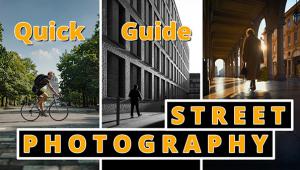10 Fun Self-Assignments
It's back—our annual collection of ideas to keep you and your camera happily occupied for hours.
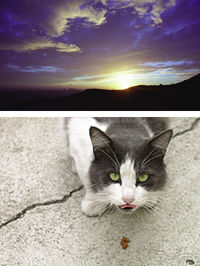 1. Don't Go Anywhere Without It!
1. Don't Go Anywhere Without It!
It's a photographic truism that you can't get the picture if you don't have a camera. How many times have you missed out on a great shot—or at least, a nice record of something you'd like to have a picture of—because you didn't feel like lugging your serious camera gear around that particular time? Well, it's really easy to hang a little point-and-shoot camera—be it film or digital—on a strap around your neck when you go most anywhere. Stuff an extra roll of film or two (or a spare memory card, if you choose a digicam) and a spare battery into a pocket, and you'll be ready to capture just about anything you encounter for future enjoyment. These shots were made with tiny point-and-shoot cameras—a digital Pentax Optio 430 (above), and an original Canon Elph APS model—carried on a bolo-tie-style neckstrap. They might not be great works of art, but the photographer is very glad he has them—and they wouldn't exist if he hadn't had that little point-and-shoot around his neck. As photographers, we should always have a camera handy, even if it's "just" an inexpensive point-and-shoot model. (If you're on a really tight budget, you can get a single-use flash camera, complete with roll of color-print film, for around $10.) Photos by Mike Stensvold
 2. Backyard Safari
2. Backyard Safari
You don't have to trek to Africa or the Amazon to get some great, natural-looking wild-animal photos. Just go to the nearest zoo, and compose carefully. The idea is to keep telltale elements out of the frame. You can do this by choosing your camera position with care, and using a long zoom lens to crop out extraneous matter. Lighting is usually most attractive in early morning or late afternoon, but check with your local zoo to see when the animals are most active (you don't want to arrive when they're sleeping, or out of view), and when the crowds are smallest (although your tight cropping should minimize crowd problems). Photos by Ron Leach
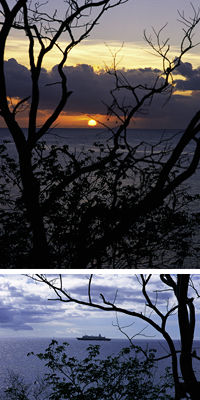 3. Same Place, Different View
3. Same Place, Different View
As the sun moves across the sky, and as the weather changes, a given scene can take on quite different "looks." So for this assignment, pick a scenic spot, and watch how it changes throughout the day, making a picture each time you notice a photogenic change. This one requires patience (and some snacks), but it's a great way to kick back, enjoy nature's splendors, and get some nice additions to your portfolio. Try horizontal and vertical compositions, and different lens focal lengths. These shots were made from a hotel-room balcony. Photos by Ron Leach
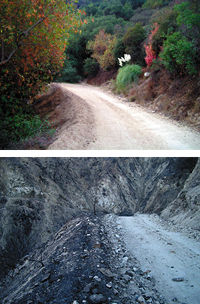 4. Contrasts
4. Contrasts
The idea for this assignment materialized during photo-hikes through the Verdugo Mountains near L.A. on successive days. The first, on the northeast side of the range, provided scenery with the expected lush loveliness. The next day's hike, just a couple of miles away on the southwest side of the range, which had recently suffered a large fire, really stood out in stark contrast to the views from the previous day's photo-hike.
Hence, the assignment: to look for contrasts, and record them with your camera. Shoot a pair of related but contrasting images. Some possibilities include day and night, rain and shine, hot and cold, large and small, black and white, color and monochrome (as we did on our hike—both shots are actually in color; the mono effect is due to the fire damage)...whatever your imagination can produce. Photos by Mike Stensvold
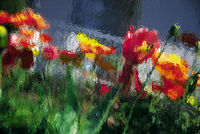 5. Mylar "Magic"
5. Mylar "Magic"
Mylar is a highly reflective material that comes in thin sheets. You can easily bend it into all kinds of shapes to create an almost infinitely variable distorted reflecting surface. Position a subject so that it is reflected in the Mylar, and photograph the results. Flowers make colorful subjects, but try anything that comes to mind.
It's a good idea to stop the lens down so that depth of field is sufficient, but selective-focus images with the lens wide open can be very effective, too. Photo by Lynne Eodice
 6. Zooms Bursting in Air
6. Zooms Bursting in Air
Zoom lenses are quite popular these days. If you're one of the many SLR users who has one, you can try a neat technique called the zoom explosion. Just make a one- or two-second exposure, and zoom the lens from one end of its range to the other halfway through the exposure. You'll get an identifiable image of the subject, plus streaks emanating from it. The best subjects are those with lots of contrast, such as the Christmas-light-clad house shown here at night. Zoom explosions are best done with the camera mounted on a tripod, but you can get some more-abstract effects by hand-holding the camera. Try zooming from wide to tele, and from tele to wide. Lenses with a zoom ratio of at least 3X produce the most dramatic results. Photos by Lynne Eodice
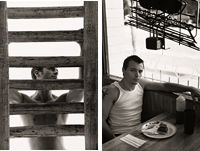 7. People & Things
7. People & Things
Pictures of people just standing there are good as record shots, but generally not very interesting. You can add interest to your people pictures by including a prop, or by photographing the subject in an "environment." You can shoot an "environmental portrait" (i.e., one that tells something about the subject's career or interests through its surroundings), or you can just catch the subject while he or she goes about his or her daily buisness. Look for interesting "frames" you can use to complement the subject. Photos by Jay Jorgenson
 8. Reflections
8. Reflections
Reflections make great photo subjects, both as compositional elements and as photo subjects. The strongest reflections occur when the subject being reflected is front lit (and the water surface is still, if the reflecting surface is a body of water), but you can find all kinds of reflections once you set your mind to it. You can get some neat abstract images by zooming in on reflections in a "disturbed" water surface. Photo by Ron Leach
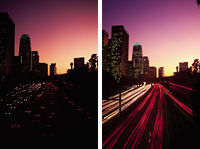 9. Explore Shutter Speeds
9. Explore Shutter Speeds
The human eye/brain combo sees things at a "shutter speed" of around 1/30 second. The camera can see at much shorter and much longer shutter speeds. Therein lies a lot of area for experimenting. Try photographing moving subjects at different shutter speeds. Good subjects include scenes containing both stationary and moving subjects, such as freeway traffic at night (mount the camera on a sturdy tripod), and subjects moving across the frame (track them with the camera while using a slow shutter speed, and you'll get a fairly sharp subject and a very blurred background that really emphasizes the subject's speed; or use a fast shutter speed to sharply freeze everything in the shot). Photos by Lynne Eodice
 10. Clouds
10. Clouds
Clouds are quite versatile. They can serve as subjects of photos, as design elements, and as backgrounds. When using them as a background, consider depth of field: If you focus on a nearby subject with the lens wide open, the clouds in the background will blur; if you shoot stopped down, the clouds will be rendered more sharply. The best thing is, all you need is a partly cloudy day. As with most outdoor subjects, the best lighting occurs early and late in the day, when the sun is low in the sky. Clouds backlit by the sun can be especially beautiful. Photos by Ron Leach














